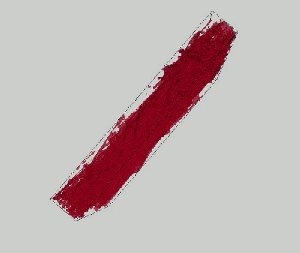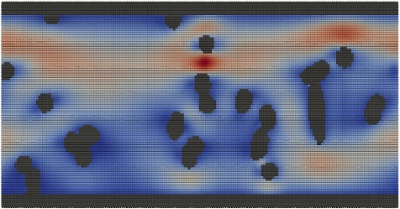Bearbeiter: Dipl.-Phys. M. Huber
Motivation
Water management is a severe problem in operation of Proton Exchange Membrane fuel cells (PEM) since liquid water impedes the access of oxygen or air through the gas diffusion layer (GDL) to the cathode catalyst. In the previous project ”Transport interactions between gas and water in thin hydrophobic porous layers“ transport in porous media has been studied experimentally on well defined porous materials and simulations have been carried out in parallel using REV-based models. Although progress has been made, several questions remain which require a more detailed simulation approach. They concern the distribution of water inside the hydrophobic/hydrophilic diffusion layer and the coupling of transport between the porous GDL and the gas distribution channels. Therefore direct numerical simulations shall be carried out which can be used later on as a reference for REV-models.

Fig. 1: Gas diffusion layer (GDL)
Model Concepts
In order to simulate two-phase transport in the porous medium we will use the grid-less method Smoothed-Particle Hydrodynamics (SPH) method [1]. The method uses interacting particles to represents the porous structure and the flowing continua. Within the method, the interaction of particles can be derived in a canonical way from the transport equations and therefore allows the comparisons with grid-based methods. Every particle carries a state vector for phase density, viscosity, pressure, velocity and temperature. As the particle can move in a Lagrangian way, the method is especially suited for complex structures with moving liquid/gas interfaces [2].
Current State of the Work
Within another DFG-funded project “Simulation of the morphogenesis of open-porous materials” a SPH-code for structure formation processes in visco-plastic and –elastic materials was developed. An additional project taking part in the DFG priority programme 1423 “process spray” uses also a particle method to describe and predict the chemical and physical processes of structure formation of single droplets during the polymerization.
Further Work planned
The existing SPH-code developed in a structure formation project which has been associated to NUPUS, has to be extended to account for phenomena like surface tension, wettability, condensation and evaporation. To perform calculations of realistic scale, numerical methods have to be improved and computations have to be parallelized. Computations shall be compared with results of direct numerical simulations using a grid-based approach and with volume-averaged methods.

Fig. 2: Water flow in porous media
For validation purposes simulations shall be compared with experiments using the experimental setup, developed in the previous project.
References
-
R. A. Gingold, J. J. Monaghan
Smoothed particle hydrodynamics: theory and application to non-spherical stars
Mon. Not. R. Astron. Soc., 181, 375-389 (1977) -
M. Yoneda, M. Takimoto, S. Koshizuka
Effects of Microstructures of Gas Diffusion Layer on the Two-Phase Flow Transport Properties
ECS Transactions (2007) 629-635

